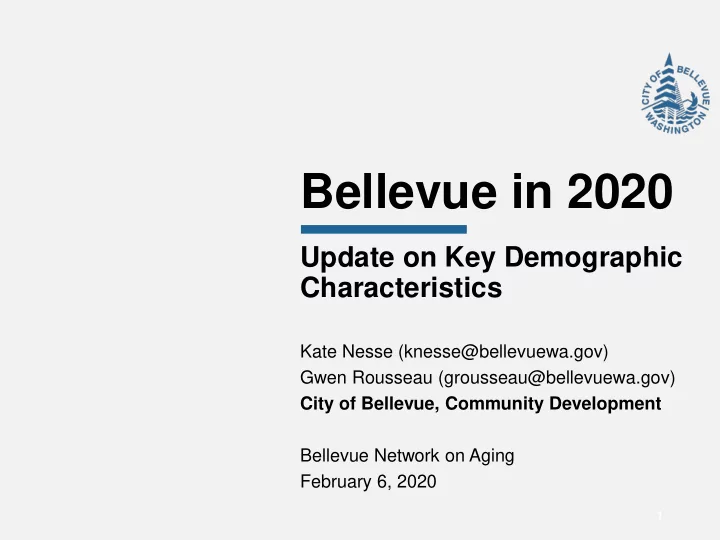

Bellevue in 2020 Update on Key Demographic Characteristics Kate Nesse (knesse@bellevuewa.gov) Gwen Rousseau (grousseau@bellevuewa.gov) City of Bellevue, Community Development Bellevue Network on Aging February 6, 2020 1
Agenda 1. Background 2. Economic Expansion & Hidden Human Capital 3. Income Inequality 4. Changing Residential Character 5. Collecting Accurate Data in the 2020 Census 2
Background Puget Sound Region: 2.75% of national population growth 3
Economic Expansion: Perspective on growth Job Growth Target Jobs grew by 18% 142,000 but population grew 138,000 by only 14% 134,000 130,000 Jobs Planned Jobs 126,000 2012 2013 2014 2015 2016 2017 2018 2019 Implications: Housing Growth Target Source: Puget Sound Regional Council. 2019. Special Tabulation of Total Population. & City of Bellevue. 2015. Comprehensive Plan. 65,000 • Longer commutes 63,000 61,000 • Higher housing 59,000 prices 57,000 Houing Units Planned Housing Units 55,000 2012 2013 2014 2015 2016 2017 2018 2019 Source: Office of FInancial Management. 2019. April 1 Housing Units, Washington State; Puget Sound Regional Council. 2019. Special Tabulation of Total Population; City of Bellevue. 2015. Comprehensive Plan. 4
Economic Expansion: Many H1-B visa recipients Washington’s Largest 1,296 accepted H1-B Visa Applicants H-1B visa applications from Company (location) 2018 companies Amazon (Seattle) 6,255 headquartered in Microsoft (Redmond) 4,471 Bellevue (2018) T-Mobile (Bellevue) 318 Expedia (Bellevue/Seattle) 287 5
Economic Expansion: Many H1-B visa recipients Implication: Women Not in The Labor Force • Highly capable Post-graduate Education population cannot work due to College Degree immigration issues High School Diploma All Puget Sound Women No High School Diploma Bellevue Non-Citizens Bellevue Citizens 0% 20% 40% 60% Source: Integrated Public Use Microdata Sample. 2018 American Community Survey (1-year estimates), published by University of Minnesota. 6
Income Inequality 28% increase in the Income by Quintile (2018 $) $500,000 Lowest Quintile Second Quintile gap between the $450,000 Third Quintile Fourth Quintile average household Highest Quintile $400,000 income for the $350,000 top 20% and the $300,000 bottom 20% of $250,000 $200,000 households $150,000 (2010-2018) $100,000 $50,000 $0 2010 2011 2012 2013 2014 2015 2016 2017 2018 Source: US Census Bureau. 2010-2018 American Community Surveys (1-year estimates), table B19081 7
Income Inequality Households with Total 45% of households Income Below Full with total income under full time Time Minimum Wage minimum wage Employment Status of ($28,080) support more than 1 person Household Head Employed 30% Unemployed 0.5% Implications: Not in Labor Force 70% • There is substantial financial need in Bellevue 8
Residential Character: Multi-Family Now Studios & 1 Beds Multi-Family Housing By Year Built 34% increase 1% 1% 1% 2% 5+ bedrooms 5% 10% 11% 12% 14% 16% 4 bedrooms in small homes 27% 3 bedrooms 32% 19% 2 bedrooms 38% 1 bedrooms 68% 50% 41% 0 bedrooms 52% 63% 51% 60% 49% 41% 31% 34% 26% 32% 22% 12% 20% 15% 13% 13% 6% 5% 6% 2% Before 1940s 1950s 1960s 1970s 1980s 1990s 2000s 2010+ 1940 9 US Census Bureau. Integrated Public Use Microdata Sample. 2013-2017 ACS, 5% sample.
Residential Character: Single-Family Homes Get Bigger Single-Family Housing By Year Built 2% decrease 1% 2% 2% 2% 3% 4% 4% 6+ bedrooms 6% 7% 12% 15% 10% 12% 5 bedrooms 14% in family-size 16% 21% 4 bedrooms 23% homes 19% 3 bedrooms 31% 18% 29% 2 bedrooms 27% increase 1 bedrooms 49% 48% 0 bedrooms in very large 41% 52% homes 48% 54% 29% 45% 50% 33% 32% 34% 23% 24% 21% 20% 16% 7% 2% 3% 3% 0% 2% 0% Before 1940s 1950s 1960s 1970s 1980s 1990s 2000s 2010+ 1940 10 10 10 US Census Bureau. Integrated Public Use Microdata Sample. 2013-2017 ACS, 5% sample.
N’hoods are Different Implications: • Loosing housing for young families • Neighborhoods are evolving within the development limits set by the City 11 11 11
Recommend
More recommend